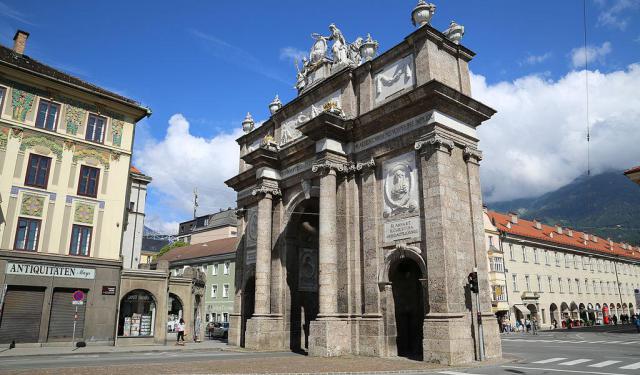
Kaiserliche Hofburg (Imperial Palace), Innsbruck (must see)
For a long time the Innsbruck Imperial Palace was the home of the ruling Habsburg dynasty in Austria. It rates among the Imperial Palace and the Schonbrumm Palace in Vienna as one of the three most important cultural edifices in the country.
It was formerly a residential compound of the Habsburgs. It still houses the Noblewomen's Collegiate Foundation, the Silver Chapel, the Court Church with the cenotaph of Maximilion, the Theological University, The Tyrolean Folk Art Museum, Innsbruck Cathedral, the Congress and the Court Garden.
The palace was initially constructed from bits of medieval fortifications by Archduke Sigismund in 1460. There were several major changes over the next 250 years. Empress Maria Theresia made Baroque alterations.
The main facade on the Street Rennweg was completed and the Giants' Hall received ceiling frescoes. The Imperial Chapel was built in the room where Francis I had died in 1765. In 1858 the last renovation of the Imperial apartments was completed. The renovations followed the Rococo style of the Schonbrumm Palace in Vienna.
The Imperial Palace contains, not only the extensive Imperial Apartments. It also holds the Gothic Hall. The hall was built in 1494. It is a five nave hall with a cross-groined vault. The area of the hall is 2,133 square feet.
The Palace Courtyard is paved with cobblestones. It has an area of 4,265 square feet. It has been called "the most beautiful inner courtyard in Innsbruck." Redone Baroque style, it features elements of pilaster, frames, cornices and cartouches. There are four portals accessing the courtyard.
The Imperial Palace has two chapels that can be used for services and events.
It was formerly a residential compound of the Habsburgs. It still houses the Noblewomen's Collegiate Foundation, the Silver Chapel, the Court Church with the cenotaph of Maximilion, the Theological University, The Tyrolean Folk Art Museum, Innsbruck Cathedral, the Congress and the Court Garden.
The palace was initially constructed from bits of medieval fortifications by Archduke Sigismund in 1460. There were several major changes over the next 250 years. Empress Maria Theresia made Baroque alterations.
The main facade on the Street Rennweg was completed and the Giants' Hall received ceiling frescoes. The Imperial Chapel was built in the room where Francis I had died in 1765. In 1858 the last renovation of the Imperial apartments was completed. The renovations followed the Rococo style of the Schonbrumm Palace in Vienna.
The Imperial Palace contains, not only the extensive Imperial Apartments. It also holds the Gothic Hall. The hall was built in 1494. It is a five nave hall with a cross-groined vault. The area of the hall is 2,133 square feet.
The Palace Courtyard is paved with cobblestones. It has an area of 4,265 square feet. It has been called "the most beautiful inner courtyard in Innsbruck." Redone Baroque style, it features elements of pilaster, frames, cornices and cartouches. There are four portals accessing the courtyard.
The Imperial Palace has two chapels that can be used for services and events.
Want to visit this sight? Check out these Self-Guided Walking Tours in Innsbruck. Alternatively, you can download the mobile app "GPSmyCity: Walks in 1K+ Cities" from Apple App Store or Google Play Store. The app turns your mobile device to a personal tour guide and it works offline, so no data plan is needed when traveling abroad.
Kaiserliche Hofburg (Imperial Palace) on Map






Sight Name: Kaiserliche Hofburg (Imperial Palace)
Sight Location: Innsbruck, Austria (See walking tours in Innsbruck)
Sight Type: Attraction/Landmark
Guide(s) Containing This Sight:
Sight Location: Innsbruck, Austria (See walking tours in Innsbruck)
Sight Type: Attraction/Landmark
Guide(s) Containing This Sight:
Walking Tours in Innsbruck, Austria
Create Your Own Walk in Innsbruck
Creating your own self-guided walk in Innsbruck is easy and fun. Choose the city attractions that you want to see and a walk route map will be created just for you. You can even set your hotel as the start point of the walk.
Innsbruck Introduction Walking Tour
Innsbruck is the capital of Tyrol, Austria. It lies in a broad valley on the river Inn, not far from the Brenner Pass. The name "Innsbruck" means "Bridge over the Inn." In the 4th century Romans established a military outpost there, calling it "Bridge over the Oeni" ("Oeni Pontum" in Latin).
In 1180 the Counts of Andechs took over the town. The Brenner... view more
Tour Duration: 1 Hour(s)
Travel Distance: 1.8 Km or 1.1 Miles
In 1180 the Counts of Andechs took over the town. The Brenner... view more
Tour Duration: 1 Hour(s)
Travel Distance: 1.8 Km or 1.1 Miles
Innsbruck's Architectural Jewels
Coveted by empires, republics and ruling dynasties over the centuries, Innsbruck has been a living treasure house of history and culture. Undoubtedly this is one of Europe's most idyllic cities, nestled amid the craggy peaks in the heart of the Austrian Alps. Innsbruck equally scores as an Alpine playground and a showcase for Hapsburg imperial heritage, and is famous for its ancient,... view more
Tour Duration: 1 Hour(s)
Travel Distance: 1.4 Km or 0.9 Miles
Tour Duration: 1 Hour(s)
Travel Distance: 1.4 Km or 0.9 Miles


